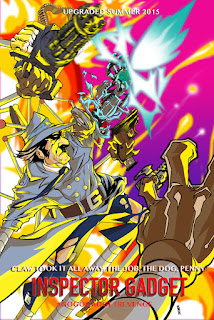Henceforth, "Comics Sunday" will now be a blog that highlights various artists found on the site Deviant Art and their awesome comic/manga work. It will be updated, as far as my plans go, every Wednesday and Sunday.
So, without any more preamble, here we go with the June 17th edition of Comics Sunday!
###
If there's one artist that you need to know about right now, it's Daniele Torres. The native Brazilian has been a hidden gem on DA for the past 5 years. She primarily does pin-ups of Marvel Comics' female stars, such as the classic Jubilee shown to your left. If you visit her gallery, you'll also find pics of Emma Frost, Domino, X-23, Supergirl, Power Girl, and probably her favorite character, Lara Croft, whom Daniele has nailed to a "T."
Daniele recently joined an art studio in Brazil, which means her commission prices have probably sky-rocketed, but the last time I checked she was charging $40 for a penciled pin-up such as this one. Daniele has a bright future ahead of her, so stay tuned...I have a feeling she's headed for bigger things!
###
 As if one great artist wasn't enough, we have another one here who excels at penciling, inking, and visual design. His name is Yildiray Cinar, and has been on Deviant Art for only a few years. He got himself noticed by DC Comics, who signed him to a contract (an all-too familiar occurrence these days) and put him to work on their New 52 Earth-2 book, with Power Girl and Huntress in the leading roles. To the right is one of Yildiray's earlier pieces, highlighting his excellent inking work as Batman heads to Gotham's slums for clues.
As if one great artist wasn't enough, we have another one here who excels at penciling, inking, and visual design. His name is Yildiray Cinar, and has been on Deviant Art for only a few years. He got himself noticed by DC Comics, who signed him to a contract (an all-too familiar occurrence these days) and put him to work on their New 52 Earth-2 book, with Power Girl and Huntress in the leading roles. To the right is one of Yildiray's earlier pieces, highlighting his excellent inking work as Batman heads to Gotham's slums for clues.I especially like this piece due to the contrast between the light & dark areas and how the window draws your attention right to Batman. Keep an eye on Yildiray's work, because he only keeps getting better.
###
You're probably sick of the Batman pics already, but this is one I just had to point out. It's by Peter Habjan, an American artist who works as a graphic designer & storyboard artist for film, TV, and animation. Peter's work is always breathtaking, since he starts with pencils and then digitally paints and colors the rest of the piece. This one, where Joker gets the drop on Batman, is probably one of my favorites, due to the lighting technique, the colors, and that priceless look on Batman's face.
Peter doesn't update his Deviant Art page very often, but when he does, it's always worth a look. Be sure to add him to your DA watch list!
###
Okay, enough about Batman--time for some green-skinned superheroine love. This pic of She-Hulk is by none other than Brazil's own Marcelo DiChiara, who actually did some fill-ins for Marvel & DC in the mid-2000's and illustrated the Power Pack & Iron Man mini-series that came out around the same time. Since then he's been posting like mad on Deviant Art, taking on Daily Sketch Challenges and going so far as to ink & color them for that professional touch.
Marcelo has a commissions post on his DA profile, but it's from 2012, so I would send him a note or e-mail before requesting his services. And hey, he's got a major thing for She-Hulk, so if you do too, so much the better!
###
Now for something completely different, as we highlight the work of comic artist Michael Watson. This particular piece caught my eye because 1) I love Inspector Gadget fan art, and 2) I love the cel-shaded coloring job on this. Michael conceived this piece as a summer blockbuster remix of Inspector Gadget, and while I think the idea was sound and the art is solid, I really don't care for all the guns popping out of him because, well, Gadget never needed guns--he had gadgets, Brain, Penny, and Penny's computer book, remember?
Michael is currently publishing his own indie comics through his publishing brand Titanium Comics, and frequently collaborates with other indie creators on DA. Check out Michael's gallery & his comics--his star is definitely on the rise.
###
And that's all for now, folks! Tune in next Sunday, same Bat-Time, same Bat-Channel (I know, enough with the Batman stuff, right?) for more spotlights on some great artists you've probably never heard of. Until then...
###
DISCLAIMER:
All art featured in this post is copyright its original owners and no copyright infringement is implied or intended. The writer did not receive any compensation for the posting of the various artists' work.













